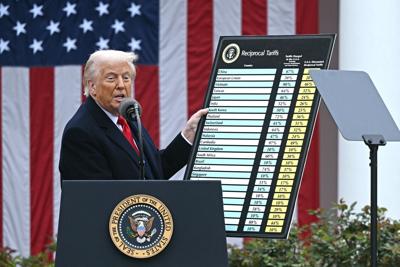U.S. President Donald Trump’s aggressive — and arguably unlawful — use of tariffs to advance his agenda has generated a level of global economic uncertainty unseen in decades.
And his open disregard for bilateral and multilateral agreements has further eroded U.S. credibility abroad, alienating both allies and rivals.
For many, Trump’s erratic conduct suggests he is either unwilling to accept sound advice or surrounded by advisers too weak to challenge him.
Yet he appears acutely sensitive to financial markets — perhaps the only source of pushback he takes seriously.
When he proclaimed “Liberation Day” in early April unveiling sweeping ‘reciprocal’ tariffs on all trading partners, the Dow Jones industrial average plunged nearly 11 per cent. Spooked by the sell-off, Trump quickly backpedaled, delaying the tariffs to give countries more time to strike deals.
Markets rebounded just as swiftly. Since then, despite his continued tariff brinkmanship, the Dow has climbed 23 per cent — but remains only about one per cent above its level when he took office — a pitiful return for all the chaos.
In mid-May, Moody’s downgraded U.S. government credit over ballooning deficits and debt. The Dow slipped less than three per cent before recovering, while yields on 30-year Treasury bonds briefly spiked to five per cent before easing.Â
A similar pattern emerged in July, when Trump signed his grandiosely named ‘One Big and Beautiful Act,’ adding over $3 trillion to the U.S. national debt over the next decade. However, markets barely reacted: the Dow dipped just one per cent, and bond yields held below five per cent.
Investors, it seems, are becoming desensitized to Trump’s tariff threats.
“The market is becoming a bit numb to these announcements,” noted City Index strategist Fiona Cincotta.
“President Donald Trump huffed and puffed again,” quipped Ed Yardeni, head of Yardeni Research. “The financial markets’ reaction was ho-hum,”Â
One metric, however, has been less forgiving.
The U.S. dollar has fallen 10 per cent against a basket of major currencies since the start of the year — a sign, Nobel laureate Paul Krugman warns, that foreign investors are losing faith in America. Yet the weaker greenback also aligns with Trump’s stated aim to boost exports and curb imports.
Notably, most of the decline occurred before Liberation Day, suggesting global investors rebalanced away from U.S. assets early on and have done little since.
So why do markets appear unconcerned about Trump’s chaotic economic policies post-Liberation Day?
Krugman attributes the resilience partly to the AI boom, arguing that “the market effects of Trump’s policies have been masked” by investor enthusiasm for tech giants. But the numbers don’t quite fit. While the “Magnificent Seven” — Alphabet, Amazon, Tesla, Meta, Apple, Nvidia, and Microsoft — outperformed the S&P 500 from 2015 through 2024, the trend has reversed this year. Since January, the S&P 500 has risen nine per cent, edging out the Magnificent Seven’s eight per cent gain.
A more convincing explanation lies in two concurrent adjustments.
First, wary of the uncertainty surrounding the new Trump administration, many investors reduced their exposure to U.S. equities and bonds before Liberation Day, contributing to the dollar’s earlier depreciation.
Second, those selling bonds often reinvested in stocks rather than hoarding cash, helping to push up equity prices and bond yields simultaneously.
The result: after Liberation Day, markets settled into a new equilibrium without a crisis or a dollar collapse. The reason is straightforward. As former Federal Reserve chair Alan Greenspan once remarked, the U.S. economy is highly flexible and capable of absorbing large shocks.
Roughly a quarter of the $36 trillion U.S. government debt is held by foreigners, mostly as central banks’ reserves. Are they likely to liquidate these holdings and invest elsewhere? Highly unlikely — for two key reasons.
First, off-loading $9 trillion in U.S. bonds overnight is impossible. Any large-scale sale would push down the dollar’s value, reducing the worth of the remaining reserves and leaving foreign holders worse off.
Second, there is simply no alternative market large and stable enough to absorb such sums. Pouring them into other countries would drive up their currencies and risk triggering economic crises.
So, for the foreseeable future, U.S. bond and equity markets will remain the world’s primary safe havens — and the dollar the reserve currency par excellence.




























To join the conversation set a first and last name in your user profile.
Sign in or register for free to join the Conversation